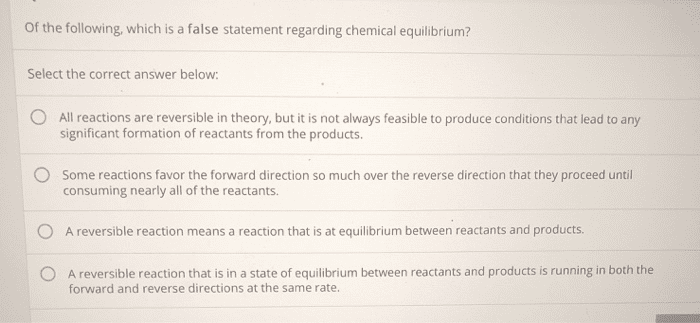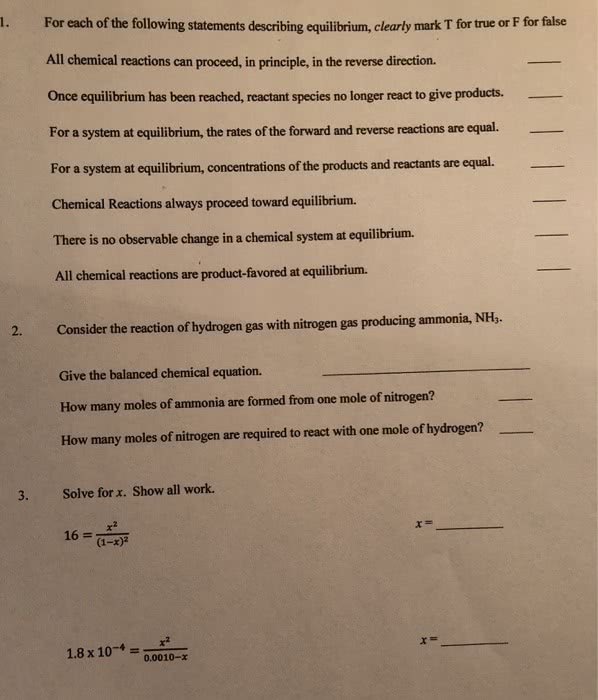CHEM10007 Lecture Notes - Lecture 22: Chemical Equilibrium, Dynamic Equilibrium, Equilibrium Constant

LECTURE 22
CHEMICAL EQUILIBRIUM
CHAPTER 9 - CHEMICAL EQUILIBRIA
9.1 CHEMICAL EQUILIBRIUM
•Many reactions proceed to completion, but many others do not have a complete conversion of
reactants to products. In some reactions, the concentrations of the reactants and products would
eventually stop changing, and we would not end up with a pure product substance, but with a
mixture of reactants and products. We say that this reaction has come to chemical equilibrium, a
situation in which the chemical composition does not and will not change with any amount of
time.
•Eg. N2(g) + 3H2(g) 2NH3(g)
•If I mixed 1 mol of N2 and 3 mol H2 in a sealed container, I would expect to get 2 mol
NH3.
•But the reaction has been reacting for 5 days and the number of moles NH3 is much less
than the expected 2 mol. Therefore, the reaction is at equilibrium.
•Using the double headed equilibrium arrow means that a chemical reaction can proceed in both
the forward and reverse directions at the same time. At equilibrium, the rates of the forward and
reverse reactions are equal; therefore the concentrations of the reactants and products remain
constant and there is no net change in the overall composition of the reaction mixture.
•Since both the forward and backwards reactions are occurring at the same rate, we say the system
is in a state of dynamic equilibrium. Also the total gas pressure remains constant (if gases are
involved).
•Not all reactions that stop are at equilibrium - some may have simply run out of limiting reagent.
•Also, ‘reactants’ and ‘products’ do not have the usual, significance because the reaction is
occurring in both directions simultaneously. Instead, reactants = RHS and products = LHS.

9.2 THE EQUILIBRIUM CONSTANT (K) & THE REACTION QUOTIENT (Q)
•For a given overall system composition at constant temperature, we always reach the same
equilibrium concentrations whether equilibrium is approached from the forward or reverse
direction.
•Generally, aA + bB = cC + dD, and when equilibrium is established, Kc = [C]^c[D]^d!
[A]^a[B]^b.
•K is the equilibrium constant; the value of the equilibrium constant expression when the system is
at equilibrium.
•Kc is the equilibrium constant expression, and it denotes that this is the concentration based
equilibrium constant. It can be used to predict or calculate reactant and product concentrations
for different situations.
•The equilibrium constant tells how far the reaction has proceeded towards completion when
equilibrium is reached.
•The products always appear on the top line of the expression, the reactants on the bottom.
•In reactions involving more than 2 products and 2 reactants, all gaseous or aqueous reactants and
products are included in the equilibrium constant expression.
•The value of Kc depends on the temp, so temp must always be specified when Kc is reported.
•Generally, Kc refers to 25C and concentration is in mol/L.
•Examples:
REACTIONS NOT AT EQUILIBRIUM
•For systems that are not at equilibrium, the equilibrium
constant expression is called the reaction quotient (Q), the numerical value of the equilibrium
constant under any conditions.
•For aA + bB = cC + dD, the reaction quotient expression is:
hQc = [C]^c[D]^d!
[A]^a[B]^b
•This differs from Kc as Kc involves equilibrium and Qc doesn’t, and Kc can have only one
positive value at a particular temp while Qc can have any positive value.
•All chemical systems will eventually come to equilibrium. When equilibrium occurs, Qc = Kc.
•In systems when Qc doesn’t = Kc, a comparison of the Qc and Kc values tells us how a system
must change in order to establish equilibrium.
•If Q = K, then the system is at equilibrium; the reaction will not go any further.
•If Qc > Kc, the system reacts to use up more products and generate more reactants, thereby
decreasing Qc until it matches Kc.



